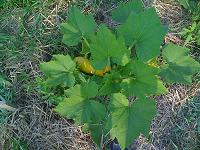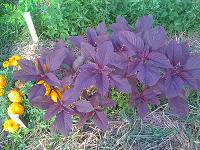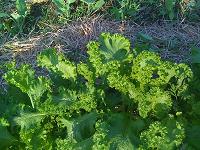Transformational Gardening
July 2009 Garden Experiences
(Back to:
June 2009 Gardening Experiences)
(Forward to:
August 2009 Gardening Experiences)
July 1, 2009
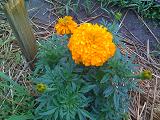 Quick visit to the garden. The marigolds I planted to help protect the squash,
pumpkin and honeydew melon from insects are doing well. Whether it's protecting
the pumpkin and squash, I have no idea. The honeydew was caviar for the insects.
Quick visit to the garden. The marigolds I planted to help protect the squash,
pumpkin and honeydew melon from insects are doing well. Whether it's protecting
the pumpkin and squash, I have no idea. The honeydew was caviar for the insects.
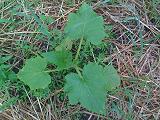 I'm very proud of the yellow straight neck squash. It's finally growing bigger.
Maybe it likes the near constant rain we've been getting for the last 10 days.
Can I throw a party for the squash? Or is it too uptight and straight-necked
(unlike the Butternut) for a party? What is the gardening etiquette?
I'm very proud of the yellow straight neck squash. It's finally growing bigger.
Maybe it likes the near constant rain we've been getting for the last 10 days.
Can I throw a party for the squash? Or is it too uptight and straight-necked
(unlike the Butternut) for a party? What is the gardening etiquette?
The kale, both Red Kale and the kale seedlings are doing well. Notice how the
white on the leaves (from last month) went away on some of the bigger kale seedlings.
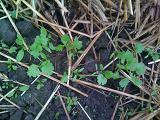 The coriander/cilantro is actually coming up in parts of Row 14! Those little leaves are
still tiny, but at least they're getting bigger. On the other hand, the Cucumber and
Zucchini are not coming up. I don't know if I need to go to the garden with my
guitar and sing an ode to the Cukes and Zucchs to entice them out of the soil.
Maybe I need to be firm, even harsh, with them: “Don't make me come in
there and get you!”
The coriander/cilantro is actually coming up in parts of Row 14! Those little leaves are
still tiny, but at least they're getting bigger. On the other hand, the Cucumber and
Zucchini are not coming up. I don't know if I need to go to the garden with my
guitar and sing an ode to the Cukes and Zucchs to entice them out of the soil.
Maybe I need to be firm, even harsh, with them: “Don't make me come in
there and get you!”
They were planted from Pagano brand seeds. The
Brussels Sprouts were also Pagano seeds and they are starting to come up. Still,
I'm going to steer away from Pagano seeds and stick with organic seeds next year.
None of the Parsley is coming up. The Italian Dark Green Parsley in Row 15 is like
a row of weeds. I should have looked on the seed package to see if it had that distinctive,
“Bag O’Weeds” seal on it.
July 5, 2009
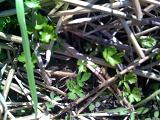 A couple of rows that weren't doing well are actually doing a bit better. The parsley is coming up
in row 15 (Italian Flat Parsley) and the left side of rows 10 and 11 (Forest Green Parsley). But the plants
are still tiny. Maybe the sunshine will help perk these little guys up.
A couple of rows that weren't doing well are actually doing a bit better. The parsley is coming up
in row 15 (Italian Flat Parsley) and the left side of rows 10 and 11 (Forest Green Parsley). But the plants
are still tiny. Maybe the sunshine will help perk these little guys up.
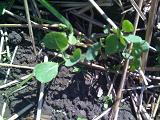 The Brussels Sprouts are coming up in row 19. But much of the row is empty. At least some of them
survived. I'm grateful for that!
The Brussels Sprouts are coming up in row 19. But much of the row is empty. At least some of them
survived. I'm grateful for that!
On the other hand, the French Breakfast Radishes on the left side of row 23 got washed away in the
10 days of rain we had. I guess they couldn't swim. There are maybe 2 or 3 radish plants left on
that side of the row. Fortunately, the Rudolph Radishes on the right side of that row are growing
like crazy.
I am very disappointed in the cucumbers, zucchini and the onions. I suspect almost every gardener
has to learn to accept failed rows. I'm not sure if I should replant those rows with something.
Hmm.... Maybe I'll try again with those plants. Okay, so I've decided that they've got until July 11th
to show themselves or I'm going to plant something else.
Overall, everything else is doing somewhere from fair to fantastic! Something to be grateful for.
July 9, 2009
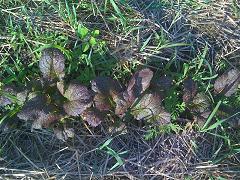 Weeds!
Weeds!
Having a weed “issue.”
Ruth
Stout was right that there would be very few weeds coming up through the
mulch. But there seems to be the exception of these grass-like weeds that are
prolific. See the picture to the right. Outside of the grass-like weeds there are
some short clover weeds that I just leave as they don't seem to be effecting the
crops. There are some other types of weeds, but not many. It is mostly these grass-like
weeds that are causing some trouble. These weeds seem to be able to grow right through
the mulch! I wonder if these weeds came from the hay I put down. Ruth Stout had this
to say:
I am asked over and over “why isn’t it bad to mulch with hay which
is full of weed seeds?” Well, if the much is thick enough, the weeds
can’t come through. When I say this, people then invariably ask why it is
that the vegetable seeds come through and the weeds seeds don’t; this is
because heavy much is on top of the latter, but not the former. As I said above, a
planting of small seeds shouldn’t be covered with mulch, or at the most
a narrow board, stip of paper or half-inch of sawdust will keep the ground soft and
moist.
I have read online discussions about the Ruth Stout method experiences and others
do not seem to be having this problem. But for me, the grass seems to be able to
push through the mulch. I ended up pulling some of the grass in the rows that was
growing thick enough to block sunlight near the smaller plants. It is possible that
after so many days of rain, the mulch is no longer thick enough to block these
grass-like weeds. Next time this happens, I'll do what Ruth Stout suggests and
just dump more mulch on the weeds to block the sunlight.
I am looking forward to next year when I use the
Natural Farming no till and weed control techniques on part of
the garden.
Many of the rows are doing well. Some still are having trouble. I plant to post more
pictures from the rows in the next few days.
July 11, 2009
Below are updated pictures of rows doing well and then rows doing poorly.
Three of the rows will be replanted because nothing is coming up: cucumbers,
zucchini and onions. All of these were Pagano seeds. Next year, I am going
to focus on crops that are native to New England.
Table 1: Rows Doing Well
| Radish (Daikon) (Row 1) |
Turnips (Row 2) |
Beets (Row 3): Not coming up in the whole row. |
Carrots (Row 4): |
Tomatos Plants (Row 5-r) |
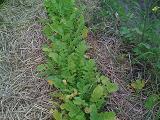 |
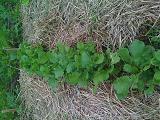 |
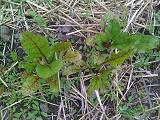 |
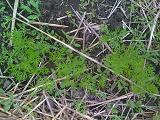 |
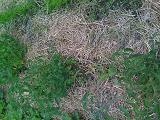 |
| Kale Seedlings (Row 5-l) |
Kale Seedlings (Row 6) |
Kale (Dinosaur) (Row 7-r) |
Kale (Red Winter) (Row 7-l) |
Kale (Red Winter) Seedlings (Row 8-r) |
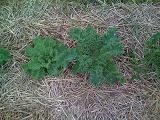 |
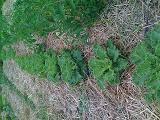 |
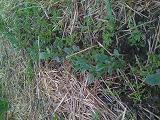 |
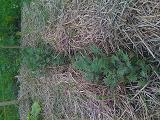 |
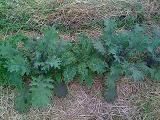 |
| Cauliflower Seedlings (Row 8-l) |
Amaranth (Burgundy) (Row 11-r) |
Mustard Greens (Red Giant) (Row 14-r) |
Coriander/Cilantro (Row 14-l) |
Leaf Lettuce (Black Seeded Simpson) (Row 16) |
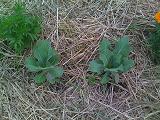 |
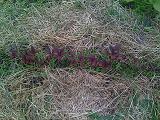 |
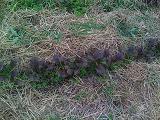 |
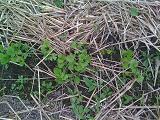 |
 |
| Mustard (Southern Giant Curled) (Row 17) |
Brussels Sprouts (Row 19) |
Radish (Rudolf) (Row 23-r |
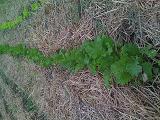 |
 |
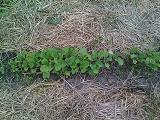 |
Table 2: Rows Doing Poorly
| Squash (Butternut) Seedlings (Row 9): Leaves turning yellow and being eaten. |
Squash (Yellow Straight Neck) (Row 10-r): Growing very slowly, if at all. |
Parsley (Forest Green) (Row 10-l): Growing very slowly. |
Parsley (Forest Green) (Row 11-l): Growing very slowly. |
Zuchinni (Row 12): Row of weeds. Nothing coming up. Will replant. |
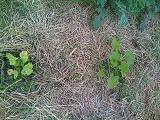 |
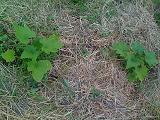 |
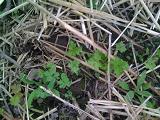 |
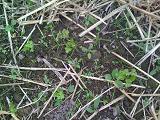 |
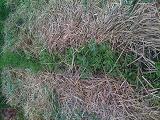 |
| Cucumber (Marketmore) (Row 13): Row of weeds. Nothing coming up. Will replant. |
Parsley (Italian Dark Green Flat) (Row 15): Growing very slowly. |
Collards (Georgia Green) (Row 18): Growing very slowly. |
Onions (Golden Onion of Parma) (Row 20): Row of weeds. Nothing coming up. Will replant. |
Honeydew Melon (Early Dew) Seedlings (Row 21-r): All eaten and dead. |
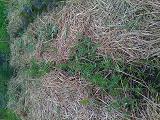 |
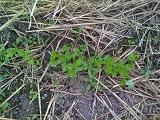 |
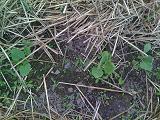 |
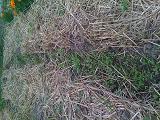 |
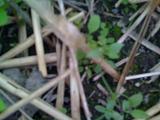 |
| Watermelon (Sugar Baby) Seedlings (Row 21-l): Not growing. |
Pumpkin (Jack Be Little) Seedlings (Row 22-l): Growing very slowly. |
Radish (French Breakfast) (Row 23-l): Most of the row was washed away by 10 days of rain. |
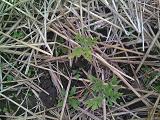 |
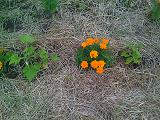 |
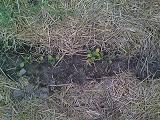 |
July 25, 2009
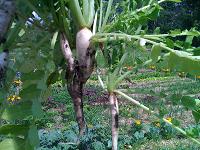
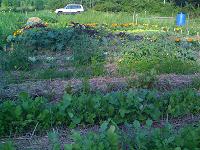 It’s been a while since I focused on the garden. Spent several hours today dealing
with some of the grass weeds that have been poking up. If I could just let if be, the
grass weeds wouldn’t harm anything. In fact, it looks like the very thick grass
was holding up some of the squash branches and tomato branches. But I couldn't get
myself to leave the weeds alone.
It’s been a while since I focused on the garden. Spent several hours today dealing
with some of the grass weeds that have been poking up. If I could just let if be, the
grass weeds wouldn’t harm anything. In fact, it looks like the very thick grass
was holding up some of the squash branches and tomato branches. But I couldn't get
myself to leave the weeds alone.
To the right is a picture of the garden from today. The Marigolds are doing great as
are many of the rows. I thinned the Daikon and Turnip rows and have some Daikon for
cooking this week. Jennifer pointed out to me that these Daikons are very spicy. I
don’t know if it is because they are still small.
The Burgundy Amaranth is growing very big. I have no idea what to do with it. But I do
know that some forms of Amaranth tend to be used for their leaves and some for their
seeds (grain). Probably going to have to research this online as I doubt my fellow
community gardeners are familiar with Amaranth. But as Jennifer pointed out, my fellow
gardeners would likely be able to answer most questions.
The Yellow Straight Neck Squash is doing well. I have a couple of squashes that are
almost ready to be picked ... I think. The mustard greens are also just about ready
to be picked.
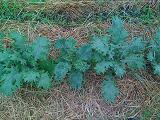
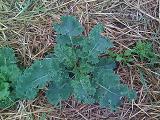
 Quick visit to the garden. The marigolds I planted to help protect the squash,
pumpkin and honeydew melon from insects are doing well. Whether it's protecting
the pumpkin and squash, I have no idea. The honeydew was caviar for the insects.
Quick visit to the garden. The marigolds I planted to help protect the squash,
pumpkin and honeydew melon from insects are doing well. Whether it's protecting
the pumpkin and squash, I have no idea. The honeydew was caviar for the insects. I'm very proud of the yellow straight neck squash. It's finally growing bigger.
Maybe it likes the near constant rain we've been getting for the last 10 days.
Can I throw a party for the squash? Or is it too uptight and straight-necked
(unlike the Butternut) for a party? What is the gardening etiquette?
I'm very proud of the yellow straight neck squash. It's finally growing bigger.
Maybe it likes the near constant rain we've been getting for the last 10 days.
Can I throw a party for the squash? Or is it too uptight and straight-necked
(unlike the Butternut) for a party? What is the gardening etiquette?

 The coriander/cilantro is actually coming up in parts of Row 14! Those little leaves are
still tiny, but at least they're getting bigger. On the other hand, the Cucumber and
Zucchini are not coming up. I don't know if I need to go to the garden with my
guitar and sing an ode to the Cukes and Zucchs to entice them out of the soil.
Maybe I need to be firm, even harsh, with them: “Don't make me come in
there and get you!”
The coriander/cilantro is actually coming up in parts of Row 14! Those little leaves are
still tiny, but at least they're getting bigger. On the other hand, the Cucumber and
Zucchini are not coming up. I don't know if I need to go to the garden with my
guitar and sing an ode to the Cukes and Zucchs to entice them out of the soil.
Maybe I need to be firm, even harsh, with them: “Don't make me come in
there and get you!” A couple of rows that weren't doing well are actually doing a bit better. The parsley is coming up
in row 15 (Italian Flat Parsley) and the left side of rows 10 and 11 (Forest Green Parsley). But the plants
are still tiny. Maybe the sunshine will help perk these little guys up.
A couple of rows that weren't doing well are actually doing a bit better. The parsley is coming up
in row 15 (Italian Flat Parsley) and the left side of rows 10 and 11 (Forest Green Parsley). But the plants
are still tiny. Maybe the sunshine will help perk these little guys up. The Brussels Sprouts are coming up in row 19. But much of the row is empty. At least some of them
survived. I'm grateful for that!
The Brussels Sprouts are coming up in row 19. But much of the row is empty. At least some of them
survived. I'm grateful for that! Weeds!
Weeds!


















 It’s been a while since I focused on the garden. Spent several hours today dealing
with some of the grass weeds that have been poking up. If I could just let if be, the
grass weeds wouldn’t harm anything. In fact, it looks like the very thick grass
was holding up some of the squash branches and tomato branches. But I couldn't get
myself to leave the weeds alone.
It’s been a while since I focused on the garden. Spent several hours today dealing
with some of the grass weeds that have been poking up. If I could just let if be, the
grass weeds wouldn’t harm anything. In fact, it looks like the very thick grass
was holding up some of the squash branches and tomato branches. But I couldn't get
myself to leave the weeds alone.